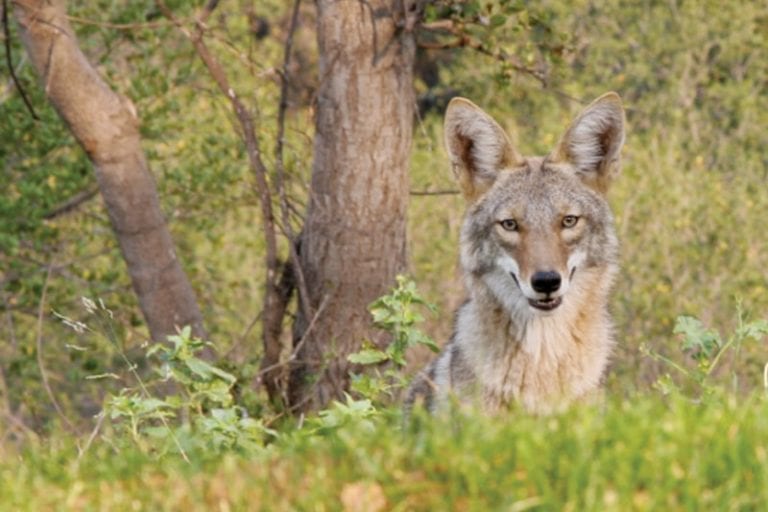
Two years ago, a coyote killed Plant City resident Amanda Rodriguez’s box terrier chihuahua mix. She found it in the field around her house, the contents of its body eaten.
For a long time after the incident, she and her husband, Frank, didn’t see the coyote.
But now — what she thinks is the same coyote — has returned. Not only is it stalking the woods around her field on South Frontage Road, the coyote is bold enough to come all the way up to the house.
“It paces on the side of the house,” Rodriguez said.
Rodriguez’s main concern lies with her four children. Three daughters live with her. One is 11 and big enough to scare the coyote off. But two are just babies — 3 and 1.
“I can’t leave my kids outside to play by the house alone with their older sister,” Rodriguez said.
A neighbor shares her concern. She came to the Rodriguez’s looking for her cat several weeks ago. Within days of the neighbor’s visit, the coyote was spotted for the first time.
Rodriguez called Hillsborough County Animal Services to see what they could do about the creature.
“They said there was nothing they could do,” Rodriguez said. “They told me I could shoot it. But I have kids. I can’t just go hunt down and kill this thing.”
TRAP OR COEXIST
Because animal services does not aid in the relocation of nuisance animals, Rodriguez’s neighbor hired a trapper.
Rodriguez said she has only seen them come out twice. One time, it began to rain, and the trapper left immediately.
The professional left traps at the border between Rodriguez’s field and woods. The traps caught a raccoon and two armadillos that sat for days, attracting vultures and possibly the infamous coyote.
The trapper cost about $300. A quote from Allstar Animal Removal, the first Google hit when searching “Plant City trappers,” lands between $389 and $489.
The quote depends on surrounding area, whether it’s wooded or in an urban setting and other factors. Allstar trappers comes for two weeks, every other day.
The Hillsborough County government website has a list of Hillsborough County trappers. Four are listed for animal trapping, only two of which will trap coyotes.
One of these trappers is Trey Larson, who has been hunting and trapping coyotes since he was 13. Within the past four years, he has taken up the hobby more. Larson will trap for free in most cases.
He said there are three ways to trap a coyote.
One more humane method uses Havahart traps. The trap consists of a cage, with a box inside. In the box, trappers can put live or dead bait such as rabbits or even pieces of raw chicken. When the coyote steps into the cage, it hits a peddle that closes the cage door.
In northern states, the foothold trap is used. Trappers cover the trap with foliage and surround it with bait. When the coyote steps on it, the trap clamps around it’s foot. The trap is illegal Florida.
The third way is to buy a predator call, which can be found at any sporting goods store. By setting a decoy up near a predator call, trappers can camouflage themselves and wait until a coyote comes to the call, thinking there is a wounded animal. Then, the trapper turns hunter by shooting the coyote.
“This is the most effective way to lure the coyote,” Larson said. “Traps can take days.”
On private property with the permission of the owner, coyotes can be hunted year-round.
“Their population is exploding,” Larson said. “They are everywhere. Even places you wouldn’t expect, (such as) neighborhoods.”
HOW TO HANDLE
Florida Fish and Wildlife Conservation Commission Wildlife Assistant Biologist Angeline Scotten said she isn’t aware of any specific studies of the coyote population, but they have spread, since being introduced in the 1960s, in the Panhandle.
Scotten works out of the Hillsborough County Office and covers 12 counties from Hernando to Lee. Of the 12 counties she oversees, there are only two from which she has not received calls regarding coyotes.
“There is a lot of myth that if you see a coyote during the day, they must be diseased,” Scotten said. “We know that they’ll be out 24/7. Especially right now. They have pups; so they are working overtime to feed their pups.”
Other calls are nuisance-based, such as coyotes bothering livestock or eating pet food off the front porch.
So what should you do if you see one?
“We encourage people to scare them away,” Scotten said. “Coyotes are timid. They are generally easy to scare.”
Scotten advises uses pots and pans, an air horn or even just standing ground and yelling at the coyote. Make sure to cause noise until the coyote is no longer in sight — or else they become accustomed to just turning their back to the noise and returning later.
“You want to make them feel unwanted and uncomfortable,” Scotten said.
If the coyotes are becoming braver and no longer seem bothered by the of noise, then call a trapper, she advises.
To help deter coyotes, feed pets indoors, secure livestock feed and trash and remove bird feeders.
Contact Amber Jurgensen at ajurgensen@plantcityobserver.com.mobile.wihack.com
